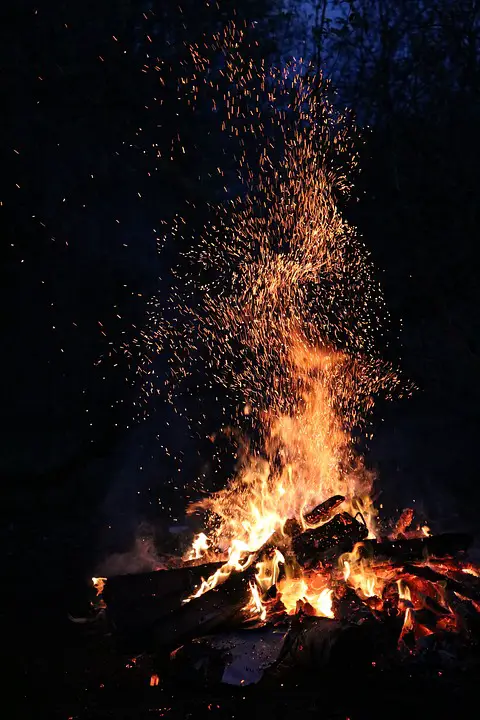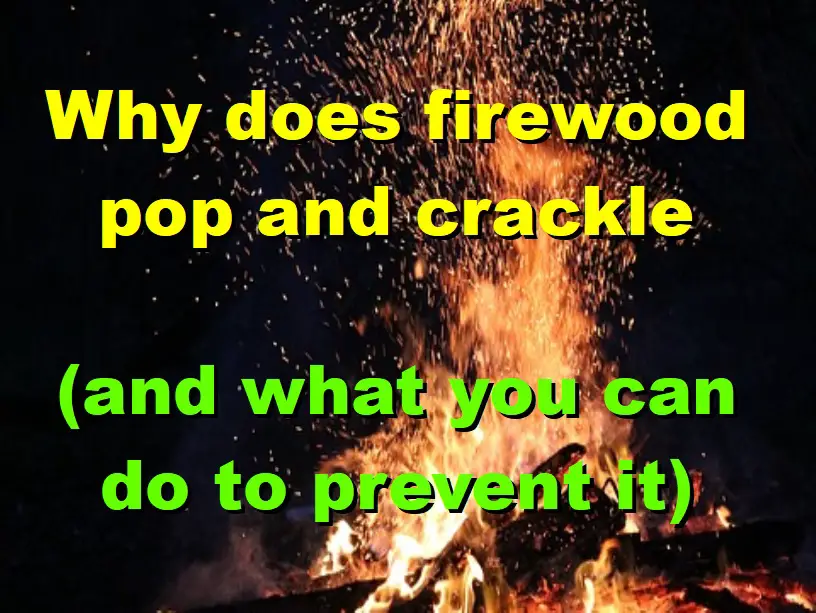A wood fire that is popping and crackling a lot can be dangerous.
Popping firewood can send red hot embers and sparks flying in the air, which can either burn you or start fires.
Keep reading to see why firewood pops and crackles, and how you can minimize it next time you light your wood stove.
- Why firewood pops and crackles
- Why there is moisture inside firewood
- Solutions and alternatives, how to stop firewood from popping
- Stack the firewood properly to ensure the fastest possible seasoning time
- Purchase kiln dried, or seasoned firewood
- Test the moisture content of the firewood before burning
- Use hardwood firewood instead of softwood
- Use the right type of firewood
- Dry out wet firewood
- Use manufactured fire logs, firewood bricks, or pellets
- Lower the burn rate / temperature of the fire
Why firewood pops and crackles
Firewood popping is different to firewood crackling.
Firewood popping occurs when burning wood has a high moisture content.
Gas is created by trapped moisture locked in small pockets within the wood. As the wood burns the moisture is heated, and as the moisture is heated it expands and turns into gas.
Once the gas pressure builds up it will create an energy burst with a mini explosion. We hear that energy burst as a pop. When the firewood pops we often see red hot firewood embers jumping around and sometimes out of the fire.
Excessive popping is caused by burning firewood that has not been properly seasoned. Also, softwoods with a high sap content can pop a lot.
Firewood crackling is due to a couple of processes when burning the wood. The first is like the above popping. Firewood crackles due to trapped moisture in the wood. The crackling is popping but without as much pressure.

Small pockets of trapped moisture create smaller pops, which we hear as crackling. This is different to popping which is from larger pockets of trapped moisture.
Firewood crackling is also caused by the release of stresses in the firewood as it is being burnt. Wood grains hold together forming tight bonds, which is what gives the tree strength. As these grains burn through they become smaller. The smaller grains are no longer able to hold back the stresses from other grains. The wood then moves in different directions, which also creates a crackling sound.
The crackling we hear is the release of those stresses as the wood grains fight against each other.
Why there is moisture inside firewood
As a tree grows it soaks up moisture from ground water which is then stored in the pores of the tree fibers. This moisture essentially waterlogs the wood. The moisture helps to carry the nutrients the tree needs to survive and grow.
Drying or seasoning firewood takes time. Depending on the type of wood and how it is stacked for seasoning it can take up to 2 years.
Trying to burn unseasoned firewood will result your firewood popping excessively. For well seasoned firewood, the moisture content should be below 20%.
Solutions and alternatives, how to stop firewood from popping
So we know that firewood with a high moisture content will pop. And popping firewood can be dangerous. It seems obvious that we need to burn dry firewood.
A few ways to help dry out and therefore prevent firewood popping are;
- Stack the firewood properly to ensure the fastest possible seasoning time
- Use kiln dried, or fully seasoned dry firewood
- Test the moisture content of the firewood before burning
- Use hardwood firewood instead of softwood
- Use the right type of firewood, some wood pops more than others
- Dry out rain soaked or wet firewood
- Use manufactured fire logs, firewood bricks, or pellets
- Lower the burn rate, or lower temperature fires
Stack the firewood properly to ensure the fastest possible seasoning time
Stacking firewood properly helps the firewood season quickly.
Properly stacking firewood also stops rain and ground water soaking into the wood. Trying to burn firewood that has recently been wet from rain will cause all sorts of problems. Which includes popping as well as sizzling. Additionally wet firewood will be difficult to light, and give off less heat.
Purchase kiln dried, or seasoned firewood
Kiln dried firewood is a great option as it has a low moisture content and is ready to burn straight away. Seasoned firewood is the same. Kiln dried and seasoned firewood is firewood that has a moisture content below 20% at the time you buy it.
Kiln dried and seasoned firewood are a great option if you dont have enough time to season firewood your self. Just be prepared to spend the extra for that convenience. You can expect to pay significantly more for kiln dried and seasoned firewood.
Test the moisture content of the firewood before burning
Most people choose to season firewood themselves. This takes time of course but sometimes it can be hard to tell when the firewood is ready and seasoned well enough to burn.
- The signs that firewood is ready to burn are;
- A moisture meter reads below 20% moisture content
- Thin pieces of firewood a snap when bent, green wood tents to bend without breaking
- The color of properly seasoned firewood will be much darker than unseasoned firewood
- Properly seasoned firewood contains less moisture and will therefore be lighter, by as much as 25%
- Pieces of seasoned firewood when struck together will give a crisp clanging sound, green wood is more a dull thud
The Environmental Protection Agency has some great firewood burning tips, including how to test for firewood moisture content.
Use hardwood firewood instead of softwood
Typically, hardwood contains less sap and moisture than softwood. Less sap equals less moisture, which equals less firewood popping.
Another benefit of hardwood is that it has more energy value, therefore hardwood burns longer and hotter than softwood.
That’s not to say you shouldn’t use softwoods at all. Softwoods are great for kindling to start a fire. But trying to keep warm through a long cold winter using softwood as the main burning firewood is just not efficient. Softwood will burn through much too fast, unless you have lots of wood you might need to replace before the season is through.
Use the right type of firewood
Its not only about hardwood vs softwood. The wrong type of hardwood can also lead to more firewood popping. Hardwood species all have different moisture and sap content when green.
Some examples of hardwood that have (on average) a lower (green) moisture content are;
These wood types will usually make for firewood less likely to pop as they contain less moisture when initially harvested.
Some examples of common hardwood that have (on average) a higher (green) moisture content are;
- Birch
- Chestnut
- Cottonwood
- Fir
- Oak
- Sycamore
- Walnut
Note, the above lists are not definitive. Sub varieties of trees offer different moisture content results. The above lists should be considered as typical, and may be useful if you have the option to choose between which type of firewood you can get.
Some examples of common hardwood that have (on average) a higher sap content are;
- Cedar
- Cottonwood
- Fir
- Redwood
- Sycamore
Dry out wet firewood
If firewood is left out in the rain it should not be used until it has had time to dry. If seasoned firewood gets wet from rain it should dry off within a day or so once stored in a dry location.
To dry wet firewood store in a dry location( inside is good) as you would when you are seasoning firewood. Stack logs to stop further contact with rain, allow sufficient airflow between each log, and raise off the ground to allow drainage.

An easy option is to store wet firewood on a grate next to the wood stove. The heat from the wood stove will dry out rain effected logs quickly.
Use manufactured fire logs, firewood bricks, or pellets
Fire logs, firewood bricks, and pellets are manufactured products that are ready to use immediately. Manufactured firewood products are by nature very dry, and have a high energy content.
These manufactured firewood products are made using production processes that densely compress the wood and remove most of the moisture. There will be no moisture pockets in these products and therefore no popping when burning fire logs, fire bricks or pellets.
Being so dense, these products are more efficient than most firewood. They will typically provide higher heat and longer burn times than normally seasoned firewood.
Lower the burn rate / temperature of the fire
This trick to burning firewood doesn’t necessarily reduce the amount of popping in any given piece of firewood. This is a trick to reduce the frequency of that popping.
The amount of moisture trapped in a firewood log is constant, it does not change. Therefore if it has trapped moisture, that moisture will create popping. If firewood has enough moisture for 100 pops then it will pop 100 times, no matter what.
The idea of reducing the intensity of the fire and therefore increasing the burn time is that those 100 pops occur over a longer period of time, decreasing the popping frequency.
Each firewood log will pop the same amount, but if you burn slower and therefore burn less firewood overall, then there is less popping. The example here is a fast burn rate might use 10 firewood logs, each with enough moisture to create 100 pops each. Thats 1000 pops for the time the fire is alight.
Burning slower might mean that you only burn 5 firewood logs before letting the fire extinguish. If those 5 firewood logs also contain enough moisture for 100 pops each, that’s 500 pops total. Much less than the above example of a hot fire and fast fire.

